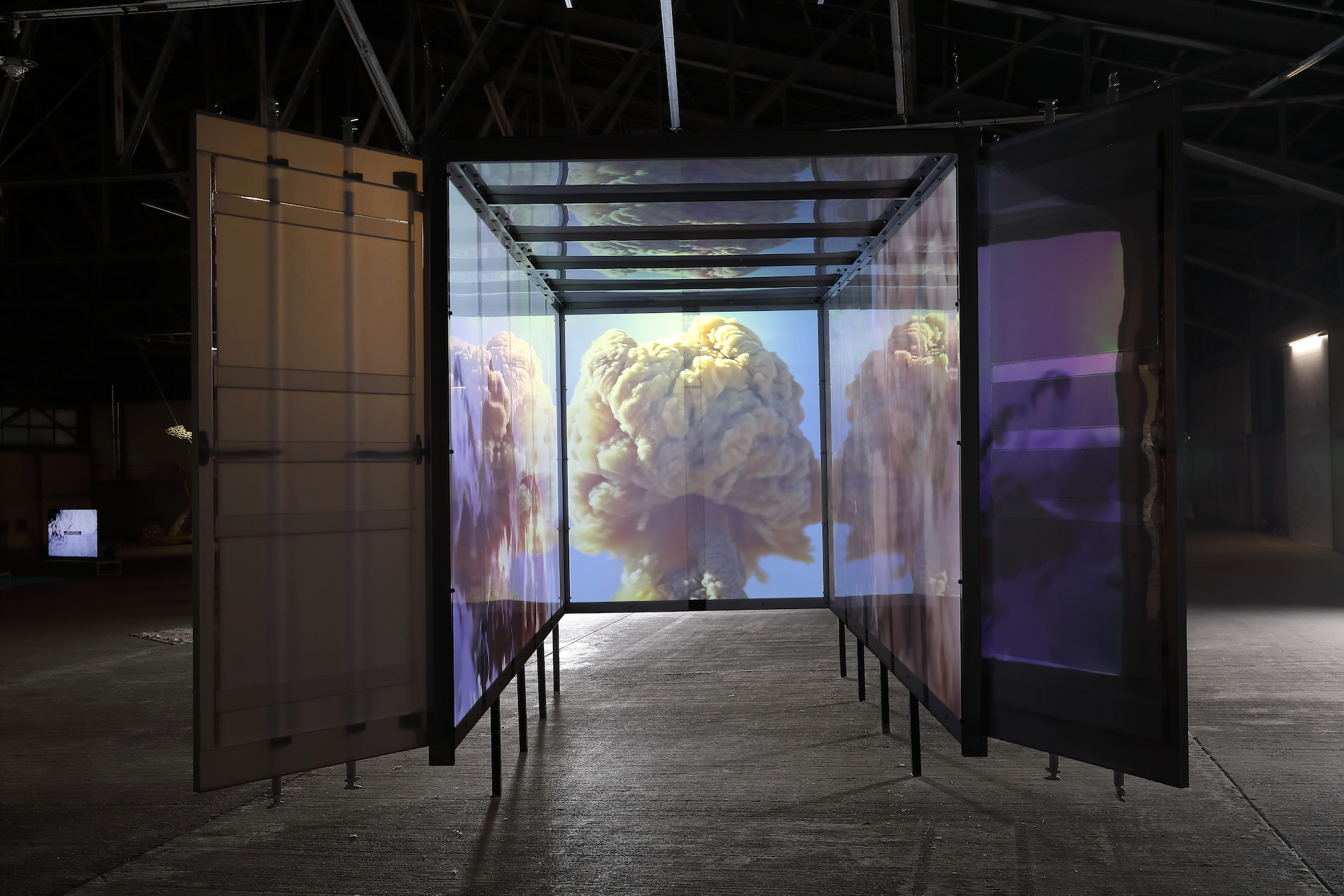
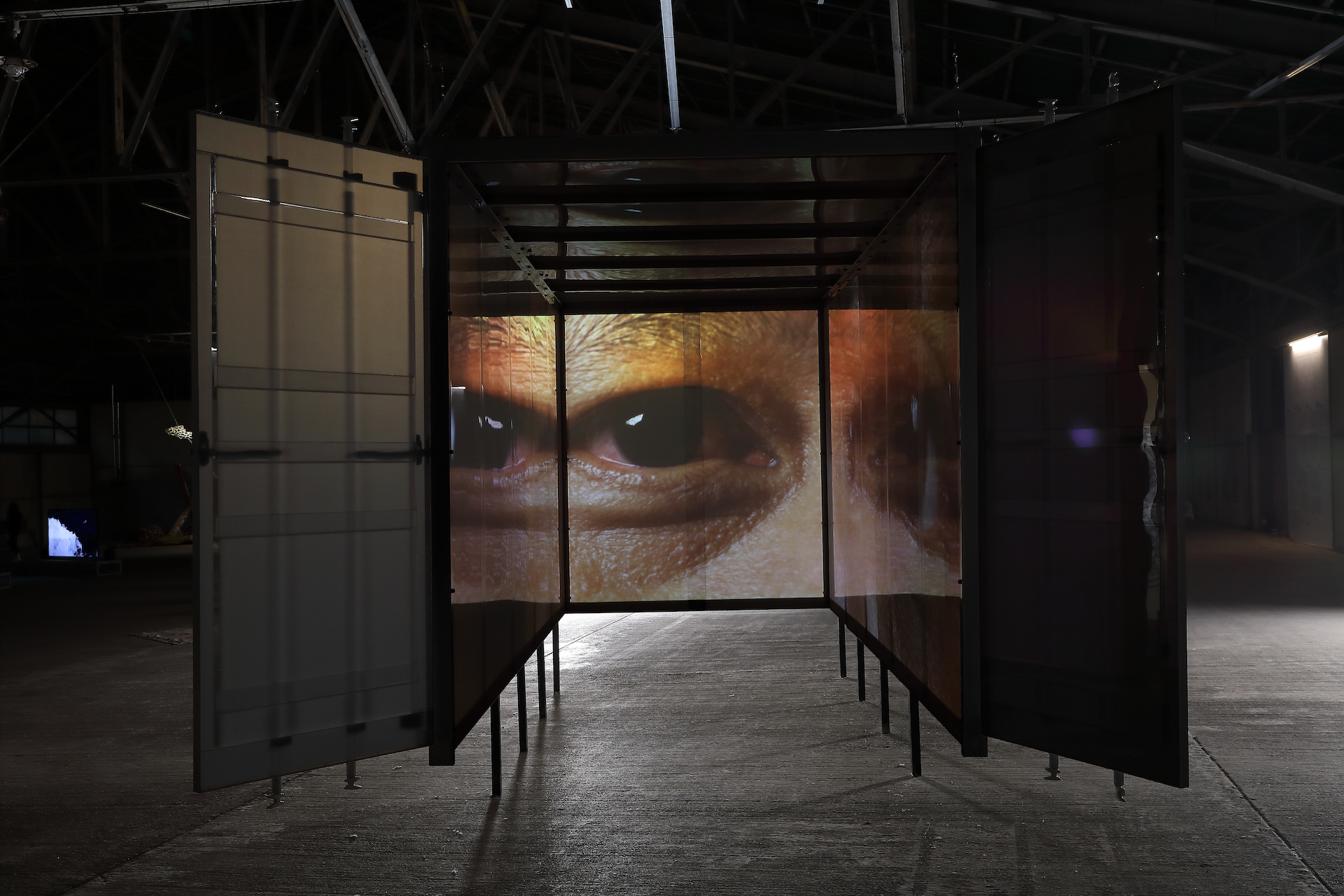
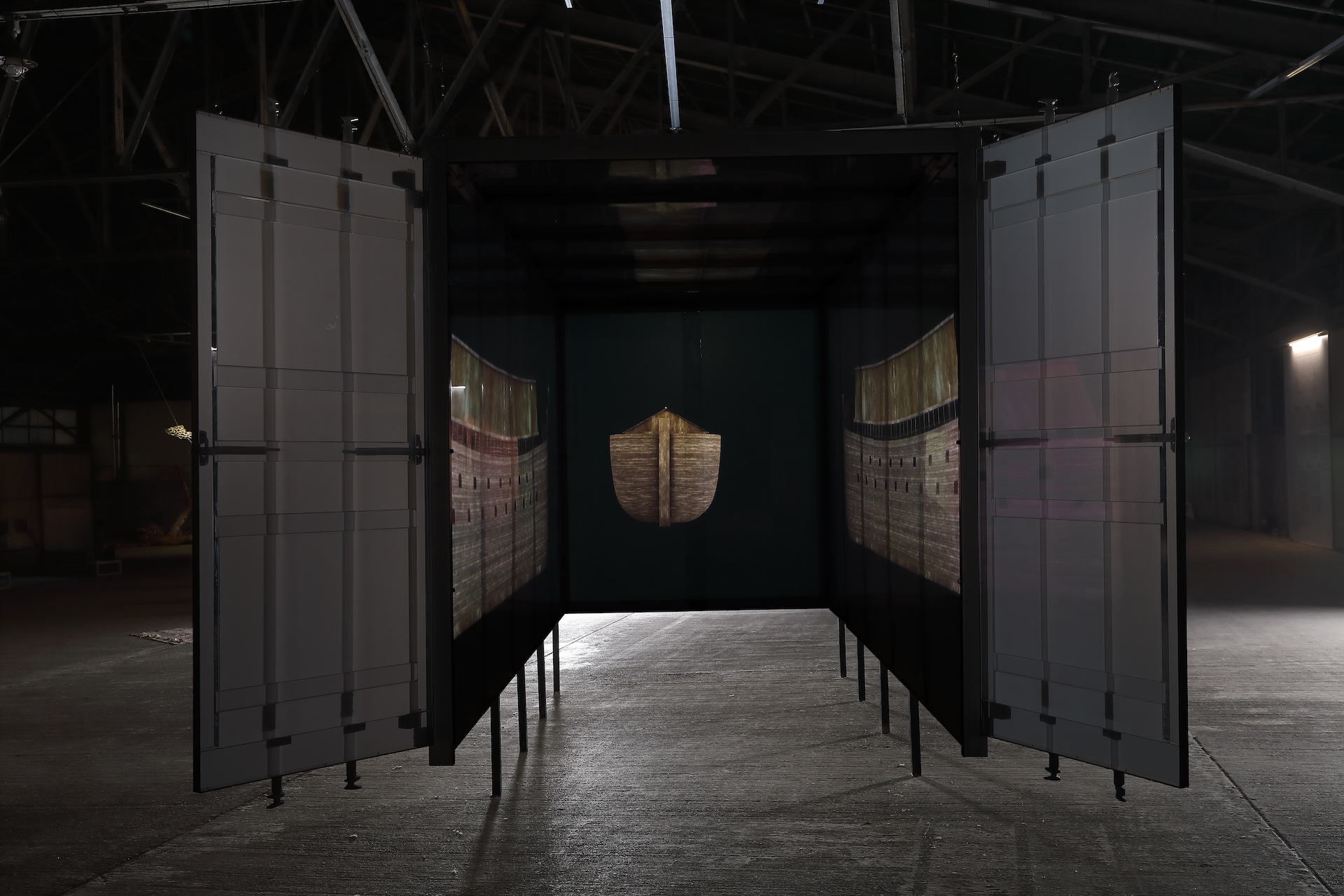
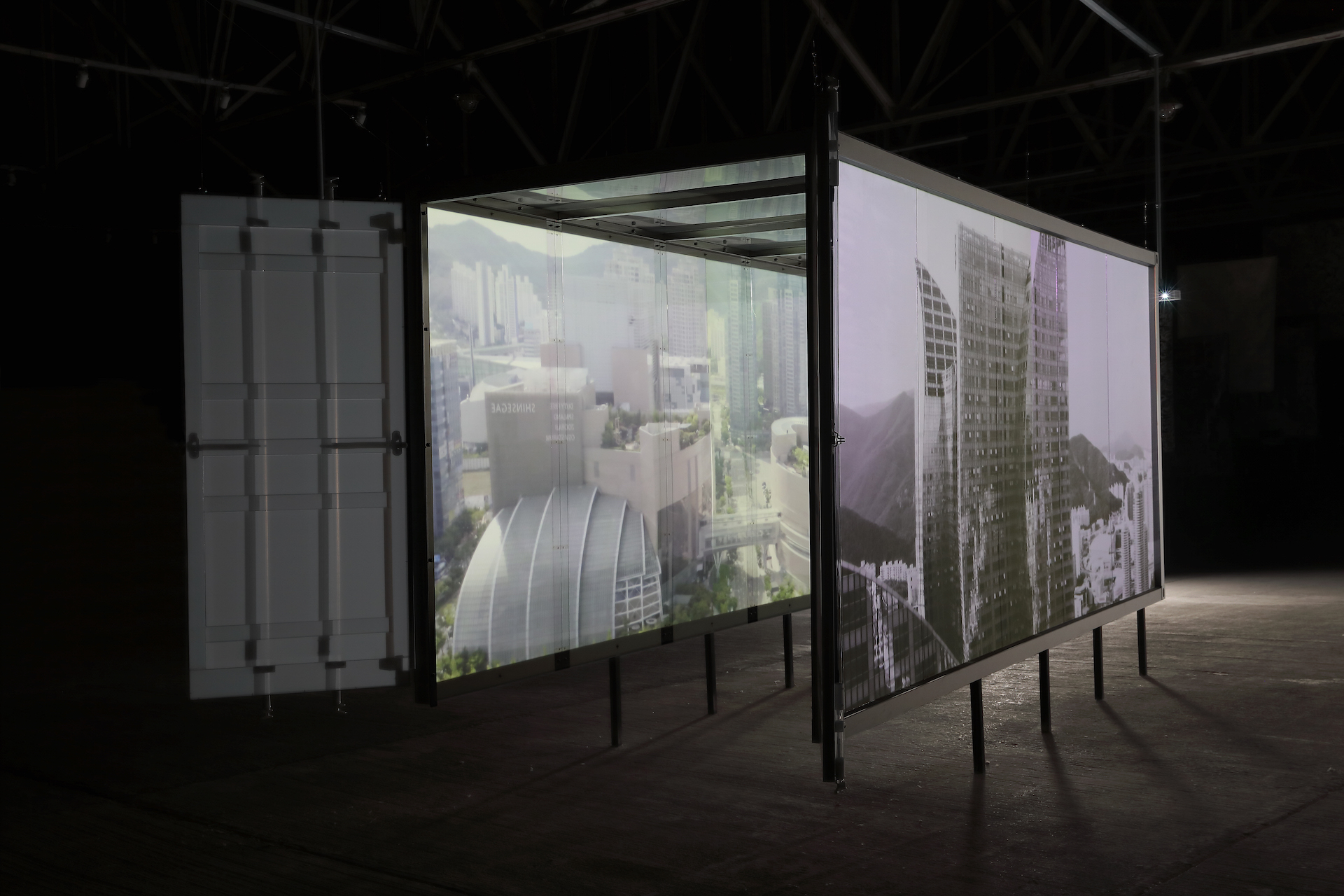

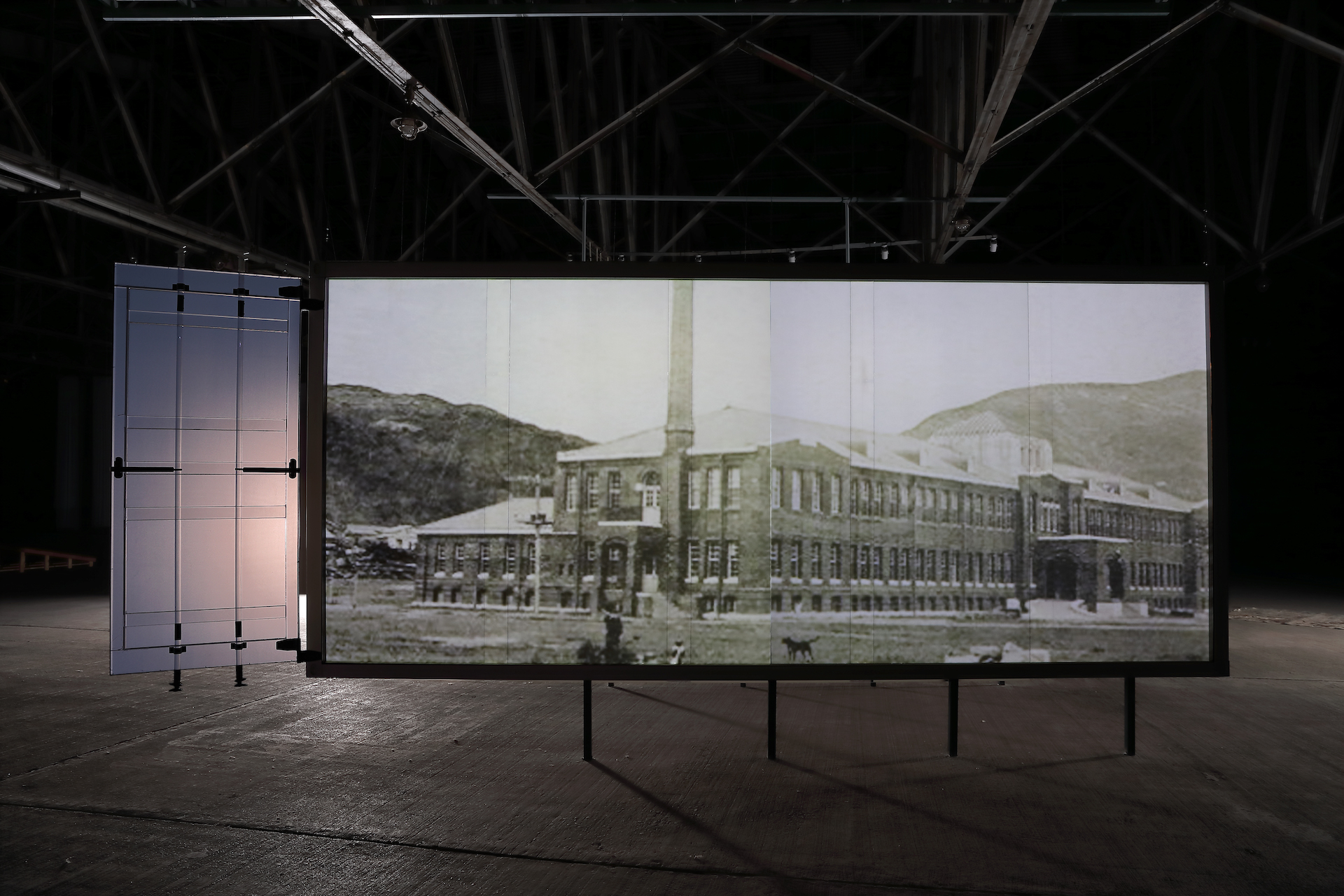


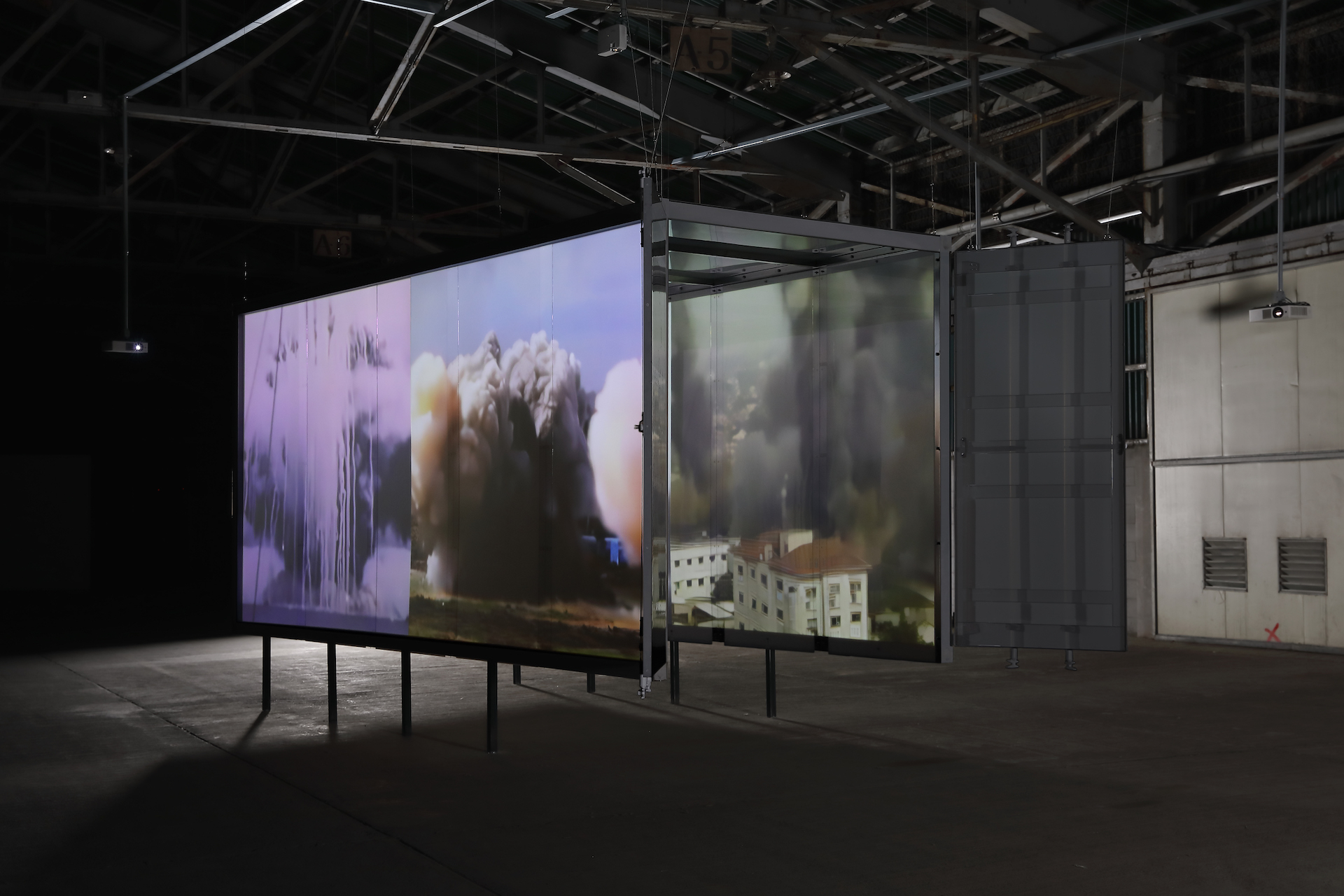
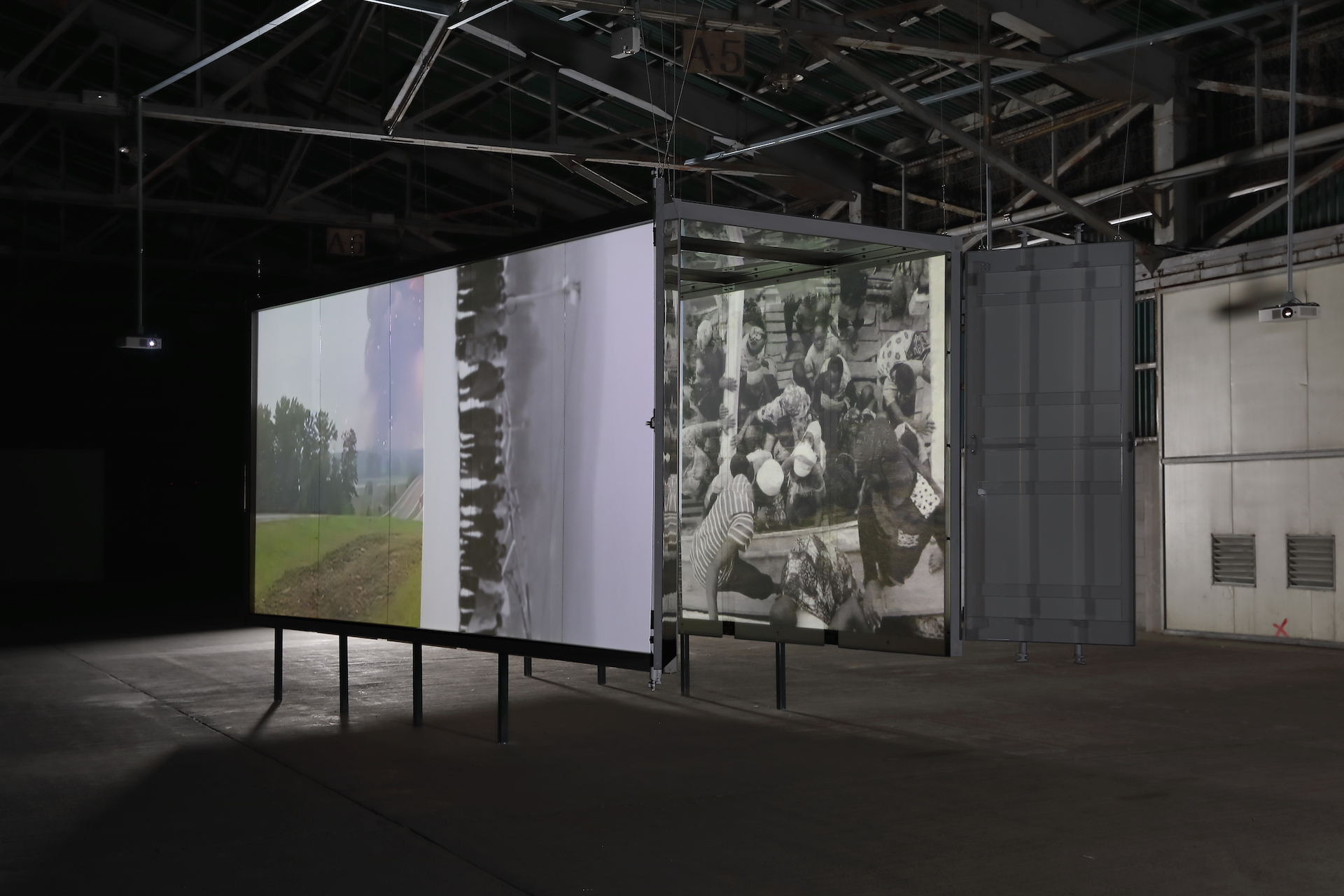
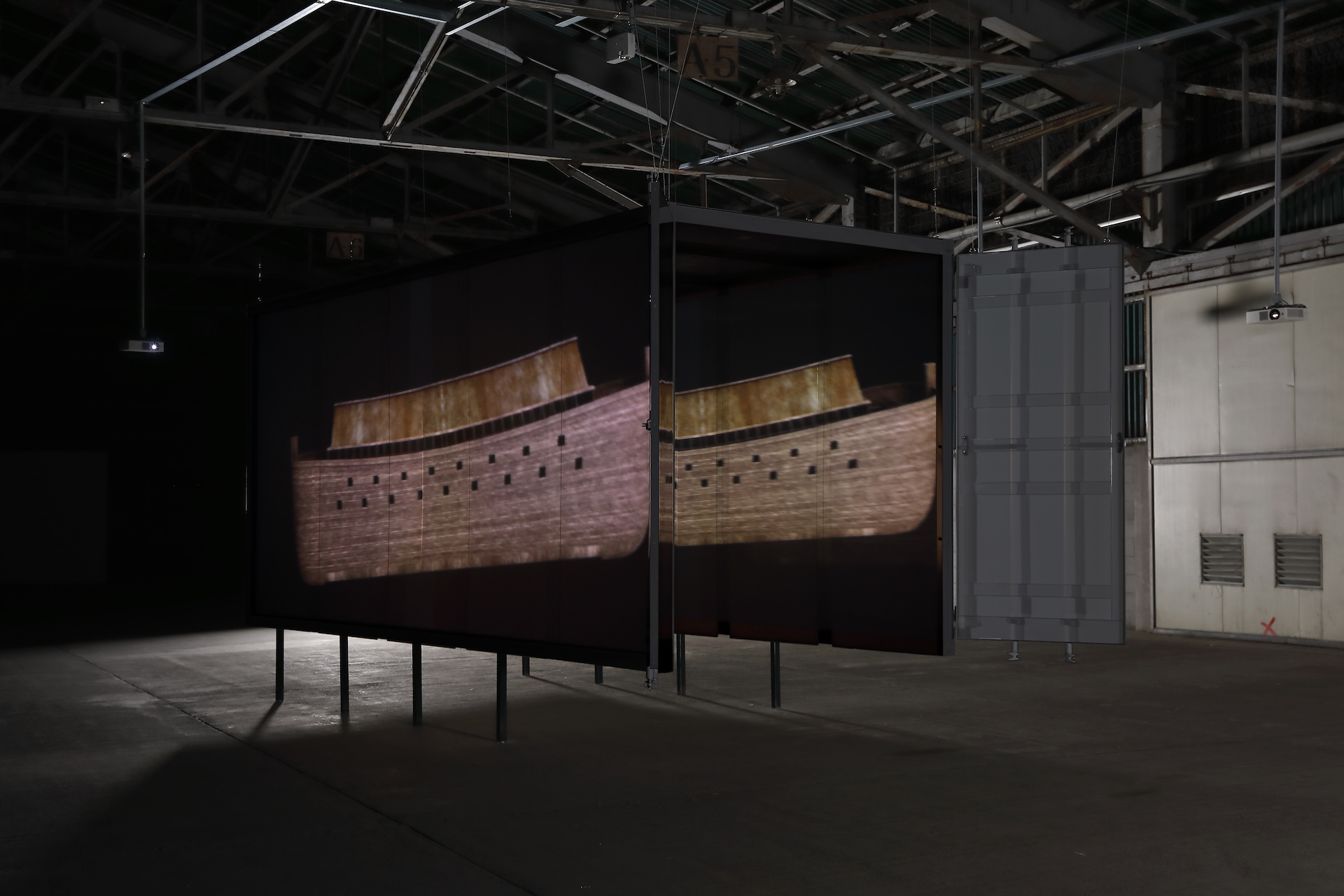
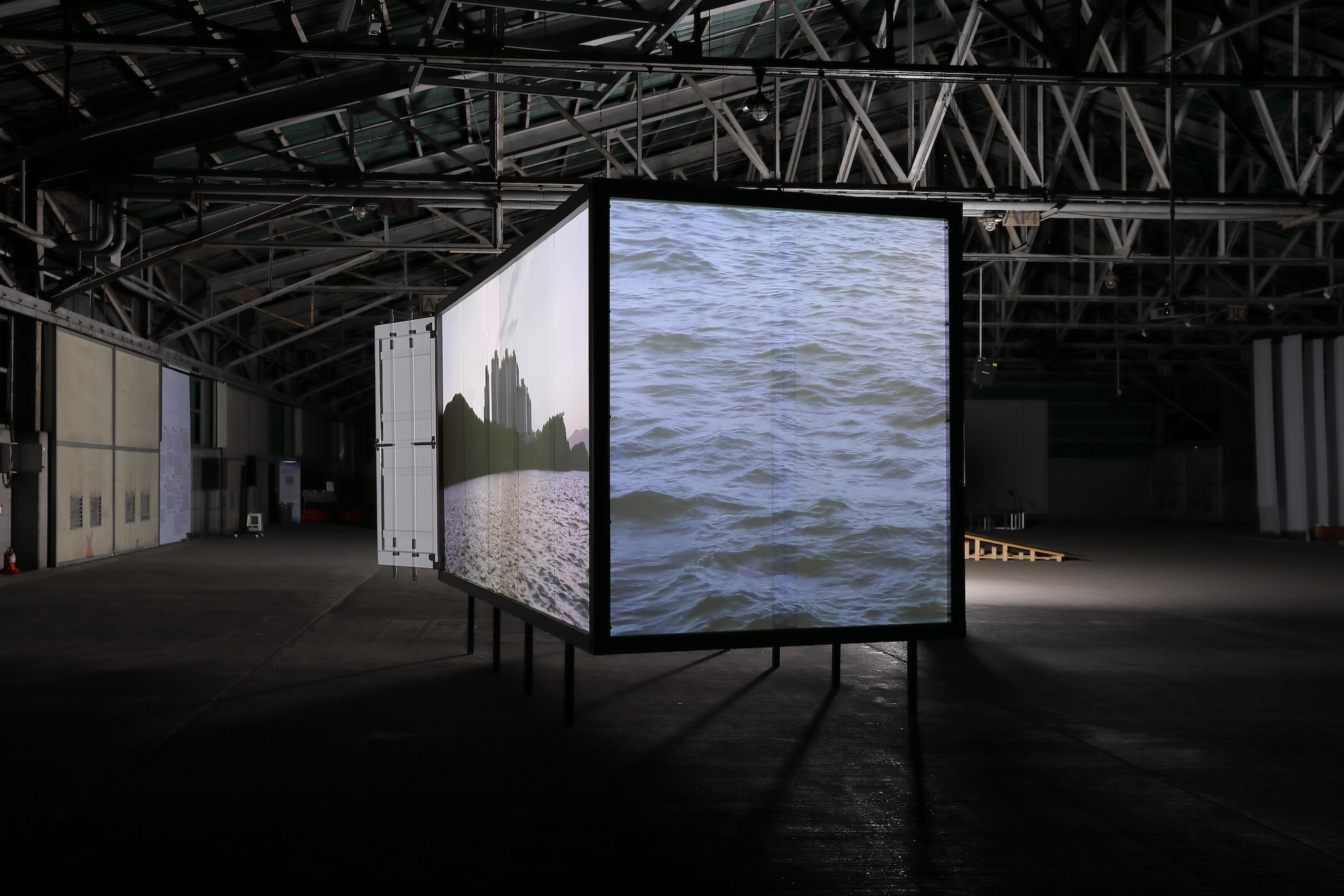
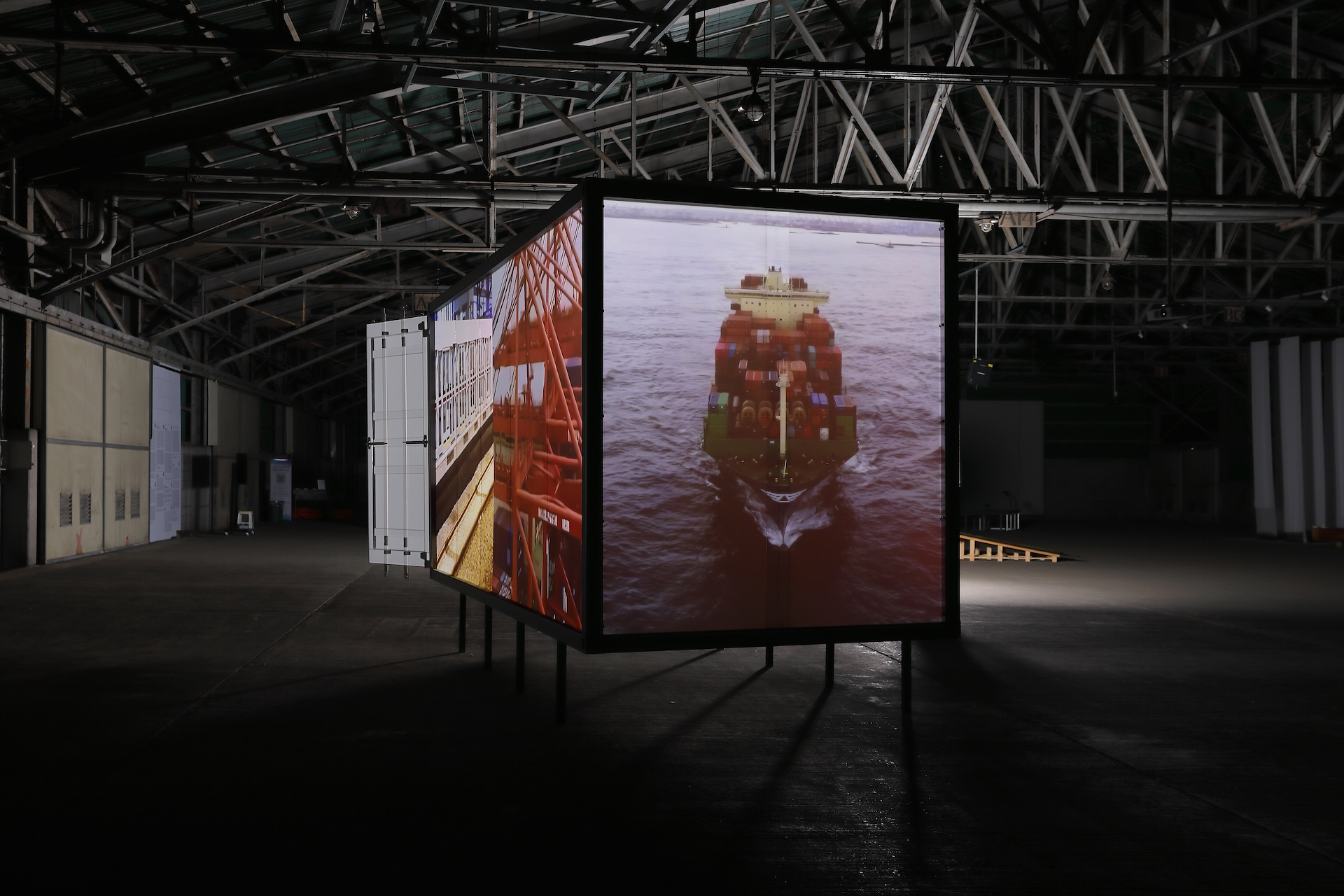
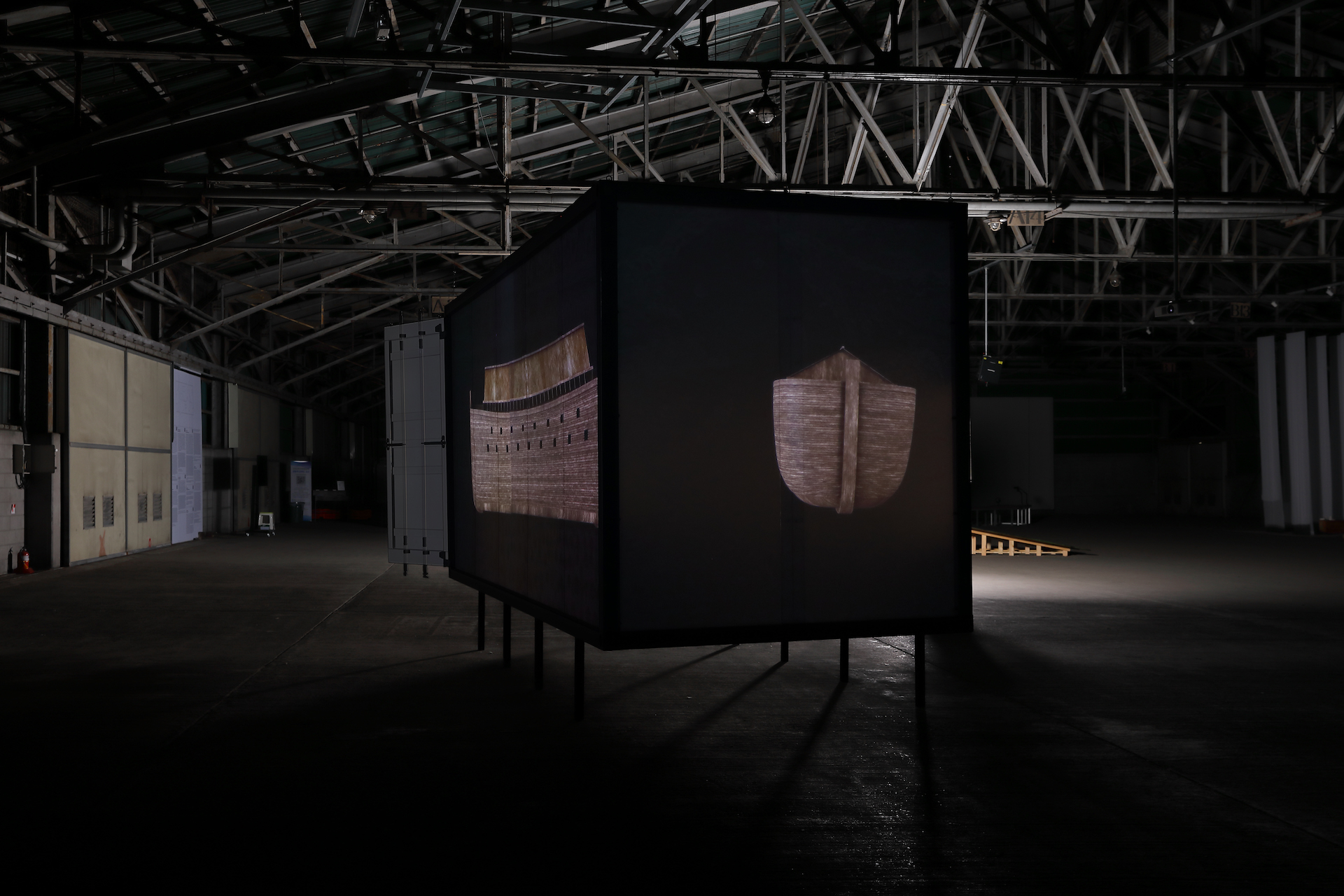
<그들은 어디로 가나이까>, 2022, 7채널 비디오 프로젝션, 프로젝션 매핑, 스테인리스 스틸, 폴리카보네이트, PVC필름,420x690x350cm, 19분 10초.
Where Are They Going, 2022 Seven-channel video, projection mapping, stainless steel, polycarbonate, PVC film, 420x690x350cm, 19min 10sec.
Where Are They Going, 2022 Seven-channel video, projection mapping, stainless steel, polycarbonate, PVC film, 420x690x350cm, 19min 10sec.
전시명: 《2022 부산비엔날레 - 물결 위 우리》 (영문: 2022 Busan Biennale - We, On the Wave)
전시기간: 2022.09.03.-2022.11.06.
전시장소: 부산항 제1부두
ⓒ 김상태. (사)부산비엔날레조직위원회 제공
ⓒ Sang-tae Kim. Courtesy of BUSAN BIENNALE ORGANIZING COMMITTEE
2022 부산비엔날레 - 물결 위 우리
부산현대미술관, 부산항 제1부두, 영도, 초량2022. 09.03 - 2022.11.06
참여작가: 가마타 유스케, 감민경, 강태훈, 그레이스 슈빈트, 김도희, 김성환, 김영조, 김익현, 김정근, 김주영, 김지곤, 남화연, 니나 바이어 + 밥 길, 라이스 브루잉 시스터스 클럽, 로르 프루보, 마르완 레치마위, 마야드 투시, 메간 코프, 무니라 알 솔, 문지영, 미카 로텐버그, 바셈 사드, 박민희, 법 인, 사사모토 아키, 산신티아 모히니 심슨, 샌디 로드리게스, 세라 워터스, 송민정, 슈 차웨이, 아딜라 술레만, 아르투로 카메야, 알렉산더 우가이, 알마 헤이킬라, 어우 슈이, 에블린 타오청 왕, 엘리사 제인 카마이클, 오석근, 오우암, 오웬 라이언, 오토봉 엥캉가, 이디스 아미투나이, 이미래, 이인미, 임충섭, 장세진(사라 반 데어 헤이드), 정희민, 제니퍼 티, 조율, 찰스 에이버리, 총 킴치우, 최호철, 침↑폼 프롬 스마파!그룹, 카바바우 마누미, 쿠킹 섹션스, 타비타 르제르, 파비앙 지로 & 라파엘 시보니, PACK, 프란시스코 카마초 에레라, 프랑코 살모이라기, 피아 뢰니케, 필리다 발로, 현남, 히라 나비
컨테이너 형태의 구조물에 영사되는 이미지는 과거로부터 현재까지 진행 중인 전쟁의 폭발 이미지를 시작으로 부산의 역사, 산업 형태의 변화와 건축물들, 사건과 사람들, 이주 노동자들의 신체 등을 중심으로 담고 있다. 한편 작가가 살고 경험했던 장소와 사건 그리고 대상 들이 시공간의 차이를 두고 중첩된다. 상호 침투하고, 공명하며 컨테이너에 구축된 이미지들은 양피지에 그린 지도처럼 도시와 인간의 역사를 담아낸다. 컨테이너는 2차 세계대전에서 고안되어 6.25전쟁에서 안정적인 병참을 수행하도록 사용되었고 근대 도시 부산은 병참 거점으로서 시작했다. 일제 강점기로부터 6.25를 거쳐 냉전의 접점에서 전지구적 자본주의가 완성되려 하는 오늘에 이르기까지 부산의 중요성은 지정학적에서 지경학적 측면으로 그 가치가 이행되고 있으며 전지구적 물류 거점의 하나로 작동하고 있다. 이제 자유로운 것은 인간이 아니라 상품이다.
점점 비물질화, 정보화되는 가상의 세계로의 이행 속에서도 여전히 컨테이너들은 전 세계 바다를 이동하고 있다. 이 작품은 부산의 항구로 유입되어 도시의 도로 곳곳에서 거칠게 이동하는 수 많은 컨테이너들을 통해 폭력의 조직화에 엮여 있는 현대 제국주의의 지도를 그린다. 자본, 상품, 네트워크 지리가 결정하는 국제적 공간을 삶의 유지와 인류의 부양을 위해 새로이 협상할 것을 제안한다.
Born and raised in Busan, Kang Tae Hun uses shipping containers to highlight how the city of Busan joined the capitalist world order as these metallic cargo holders traversed across globe, connecting one city to another. Kang also unveils the lives of the marginalized who were pushed aside in the process.
Projected on a structure shaped like a shipping container, Kang’s work begins with images of explosions from the wars that plagued the world long since the past. Kang then goes on to capture the history of Busan, the transformation of the city’s industries and architecture, incidents and people, and the bodies of migrant workers. Meanwhile, the locations, events, and subjects that Kang personally experienced are overlaid across different locations and points in time. The mutually intrusive and resonating images stacked atop the container capture the history of cities and humanity much like a map inked on parchment. Originating in World War II, shipping containers became a staple in Busan during the Korean War as the city was transformed into a modern hub of logistics. Evolving throughout the Japanese occupation, Korean War, Cold War, and the near-completion of pan-global capitalism today, Busan has proven to be a valuable city geopolitically at first, but now also geoeconomically as it functions as one of the key logistics hubs in the global trade network. Freedom is now something enjoyed not by people, but commodities.
Despite the increasing dematerialization and digitalization of this world, shipping containers continue to roam the seas across the globe. By using these containers that enter Busan Harbor to brutishly roam the roads across the country, Kang’s work pens out a map of modern imperialism fraught with organized violence. In a world where capital, commodities, and network geography define the international space, Kang suggests a new negotiation be reached for the sustainment and betterment of humanity.
점점 비물질화, 정보화되는 가상의 세계로의 이행 속에서도 여전히 컨테이너들은 전 세계 바다를 이동하고 있다. 이 작품은 부산의 항구로 유입되어 도시의 도로 곳곳에서 거칠게 이동하는 수 많은 컨테이너들을 통해 폭력의 조직화에 엮여 있는 현대 제국주의의 지도를 그린다. 자본, 상품, 네트워크 지리가 결정하는 국제적 공간을 삶의 유지와 인류의 부양을 위해 새로이 협상할 것을 제안한다.
Born and raised in Busan, Kang Tae Hun uses shipping containers to highlight how the city of Busan joined the capitalist world order as these metallic cargo holders traversed across globe, connecting one city to another. Kang also unveils the lives of the marginalized who were pushed aside in the process.
Projected on a structure shaped like a shipping container, Kang’s work begins with images of explosions from the wars that plagued the world long since the past. Kang then goes on to capture the history of Busan, the transformation of the city’s industries and architecture, incidents and people, and the bodies of migrant workers. Meanwhile, the locations, events, and subjects that Kang personally experienced are overlaid across different locations and points in time. The mutually intrusive and resonating images stacked atop the container capture the history of cities and humanity much like a map inked on parchment. Originating in World War II, shipping containers became a staple in Busan during the Korean War as the city was transformed into a modern hub of logistics. Evolving throughout the Japanese occupation, Korean War, Cold War, and the near-completion of pan-global capitalism today, Busan has proven to be a valuable city geopolitically at first, but now also geoeconomically as it functions as one of the key logistics hubs in the global trade network. Freedom is now something enjoyed not by people, but commodities.
Despite the increasing dematerialization and digitalization of this world, shipping containers continue to roam the seas across the globe. By using these containers that enter Busan Harbor to brutishly roam the roads across the country, Kang’s work pens out a map of modern imperialism fraught with organized violence. In a world where capital, commodities, and network geography define the international space, Kang suggests a new negotiation be reached for the sustainment and betterment of humanity.